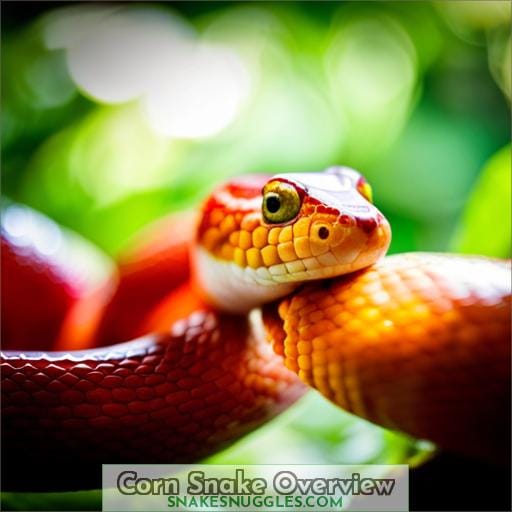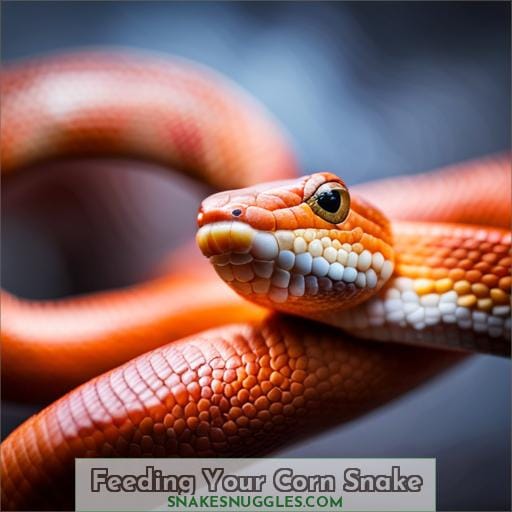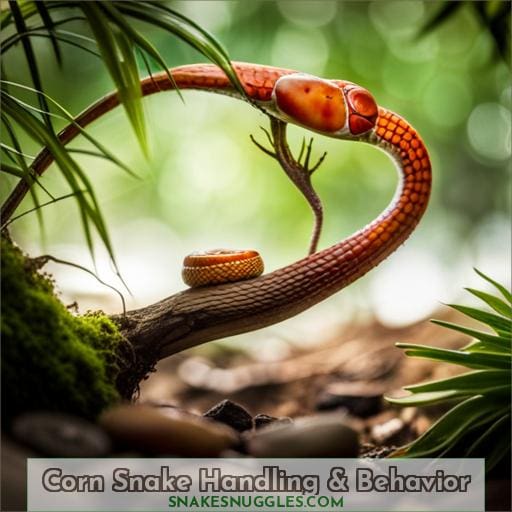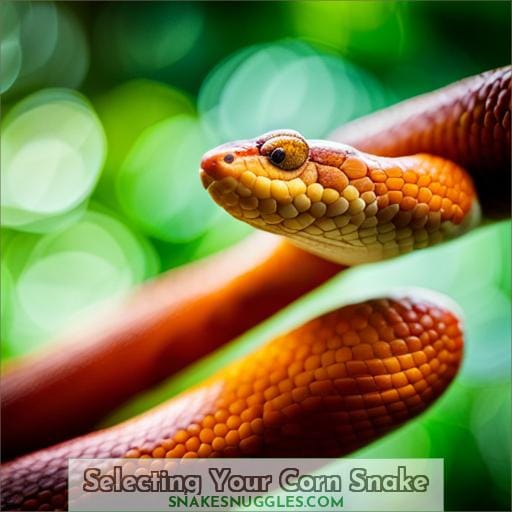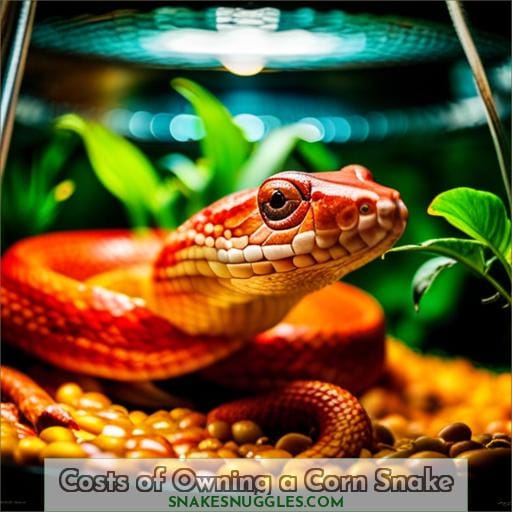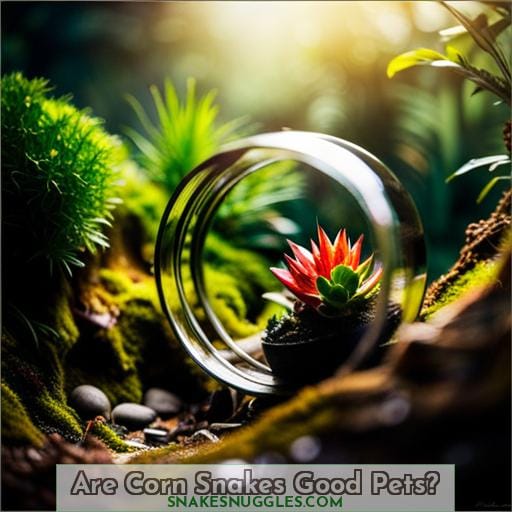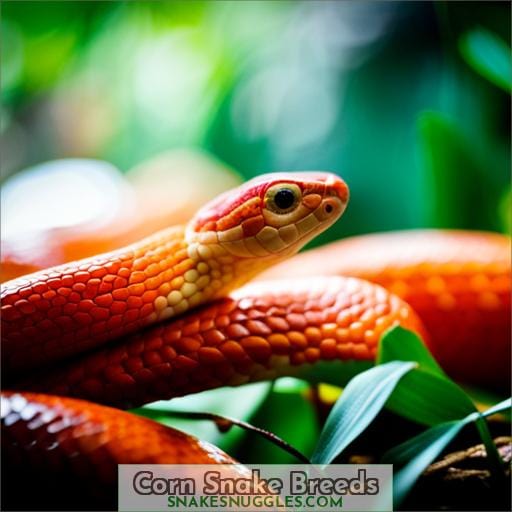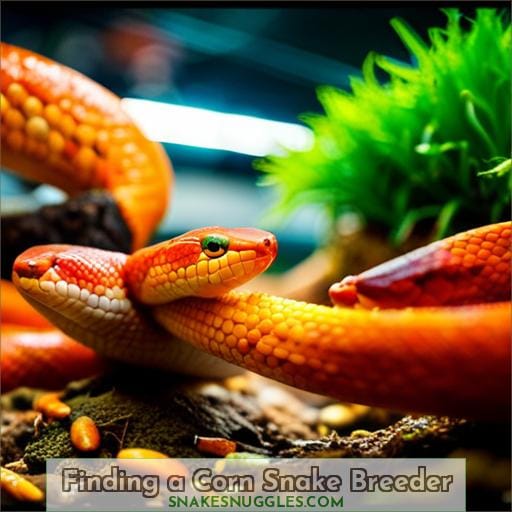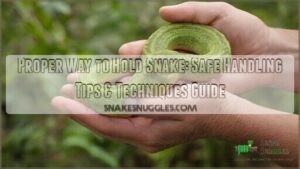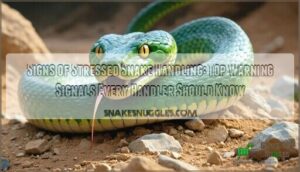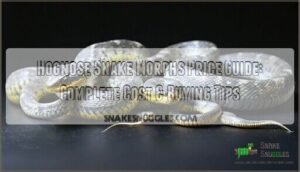This site is supported by our readers. We may earn a commission, at no cost to you, if you purchase through links.
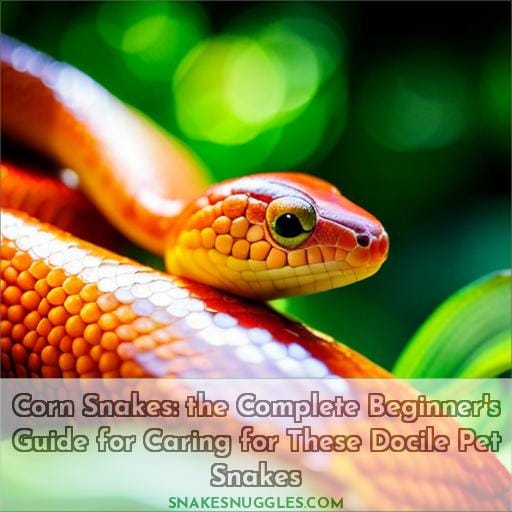 As they say, the early snake catches the mouse! You’ll find few reptile pets as fascinating yet easygoing as corn snakes. From proper housing to ideal feeding routines, this guide shares my decades of know-how on keeping healthy, docile corn snakes.
As they say, the early snake catches the mouse! You’ll find few reptile pets as fascinating yet easygoing as corn snakes. From proper housing to ideal feeding routines, this guide shares my decades of know-how on keeping healthy, docile corn snakes.
Whether you’re a first-timer or seasoned herper, you’ll discover tips on these snakes’ behaviors, care standards, and costs—knowledge to give your new scaly friend a lifetime of belly rubs.
Table Of Contents
- Key Takeaways
- Corn Snake Overview
- Housing Your Corn Snake
- Feeding Your Corn Snake
- Corn Snake Handling & Behavior
- Common Health Issues
- Selecting Your Corn Snake
- Costs of Owning a Corn Snake
- Are Corn Snakes Good Pets?
- Corn Snake Breeds
- Finding a Corn Snake Breeder
- Frequently Asked Questions (FAQs)
- What cleaning and sanitation practices should be used for a corn snake enclosure?
- How often does a corn snake need to be taken to a veterinarian for a health checkup?
- What signs indicate a corn snake may be stressed or unhappy with its environment or handling?
- Is there an ideal time of day to interact with my corn snake? When are they most active?
- What emergency first-aid steps should be taken if a corn snake stops eating or acts lethargic?
- Conclusion
Key Takeaways
- Generally docile temperament makes them suitable for routine handling
- Require proper husbandry like appropriate enclosure size and temperatures
- Feed on prey like mice; adjust quantity and size as they grow
- Monitor for signs of illness and take to a veterinarian if concerns arise
Corn Snake Overview
Depending on their age and size, corn snakes range between 30-48 inches long with orange blotches bordered in black on brownish or grayish backgrounds.
Found throughout mainland Florida and the Keys, these non-venomous snakes aren’t dangerous to people or pets, though they may bite if provoked.
They can be distinguished from similar species like mole kingsnakes by their spear-shaped head pattern and lack of dark stripes down the back.
Those new to snake ownership should properly set up an enclosure with ideal temperature gradients before acquiring a corn snake, which can make for a docile, handleable pet if cared for correctly.
Coexisting with wild snakes simply requires avoiding direct contact and learning proper identification.
Housing Your Corn Snake
When keeping corn snakes as pets, you must set up an appropriate enclosure with suitable substrates and maintain proper temperature and humidity levels.
Provide a secure glass tank or other escape-proof habitat, outfit it with hiding spots, climbing branches, and clean bedding, and use thermometers and hygrometers to monitor conditions.
Getting housing right from the start ensures your snake stays healthy and content in its home.
Enclosure
You’ll need to house your corn snake in a secure, properly sized enclosure with all of the necessary furnishings.
Ensure the enclosure has a tight-fitting lid to prevent escape.
Include hides, branches, and water dish for enrichment.
Use a heat lamp to create a temperature gradient.
Monitor humidity levels with a hygrometer.
Substrate
When choosing a substrate for your corn snake’s enclosure, you’ll want to select a material that:
- Retains heat and humidity
- Allows your snake to burrow comfortably
Consider options like cypress mulch, orchid bark, or a soil and sand mixture. Avoid substrates like cedar shavings.
| Substrate | Pros | Cons |
|---|---|---|
| Cypress mulch | Holds humidity well, natural feel | Can mold if too wet |
| Orchid bark | Good drainage, easy to clean | Doesn’t hold humidity very long |
| Soil/sand mix | Allows for burrowing | Can be messy over time |
When selecting the optimal substrate for your corn snake, you should also consider:
- Humidity management
- Shedding
- Cleaning needs
- Enrichment
Temperature & Humidity
Before setting up your corn snake enclosure, you’ll need to ensure proper temperature and humidity ranges are maintained.
Use a thermometer and hygrometer to monitor gradients, providing heat lamps for warm zones and moisture for shedding.
Seek veterinary guidance if observing signs of respiratory infection.
Feeding Your Corn Snake
Frequently, you’re feeding younger cornsnakes every 5-7 days, while adults can be fed weekly or bi-weekly.
- Prey should be no wider than 1.5x the snake’s width. Overly large meals can cause health issues.
- Offer varied prey like mice, small rats, and quail for balanced nutrition.
- Adults eat less frequently depending on size and metabolism.
- Ensure access to fresh, clean water at all times.
When handling after feeding:
- Wait at least 2 days to allow proper digestion.
- Wash hands thoroughly, as scent of prey on hands may cause defensive bites.
- Avoid sudden movements that could regurgitate meal.
Gentle handling assists proper digestion for a healthy, thriving corn snake. Monitor prey size and feed according to age and size.
Corn Snake Handling & Behavior
You’ll usually want to gently lift cornsnakes with one hand placed near the head and the other near the tail when handling them for short periods to prevent stress or biting.
Limit handling duration to 10-15 minutes at a time to prevent temperature drops that could compromise their health.
Observe the snake’s body language and avoid handling if they display a defensive S-shaped neck posture.
Thoroughly wash hands after feeding before interactions to prevent accidental bites triggered by the scent of food.
As captivity bred pets, cornsnakes exhibit docile behavior with humans, but may bite under duress or mistaken hunger.
Carefully support a cornsnake’s body when lifting it, avoiding fast movements that could trigger defensive reactions.
With routine gentle handling, these mild-mannered snakes become comfortable with human interaction.
Common Health Issues
Many common health issues for corn snakes can be prevented with proper husbandry and close monitoring. As their owner, you’re responsible for providing the right environment and nutrition to keep your snake healthy.
Stay alert to signs of illness and be prepared to take action if problems arise.
- Provide proper temperatures and humidity levels to prevent respiratory infections.
- Look for signs of mites like irritated skin and treat promptly.
- Support healthy shedding by maintaining humidity.
By staying informed on their care needs and behavior, you can catch issues early and get veterinary help if needed. Building an understanding of their requirements for belonging and safety will strengthen your bond with these docile pets.
With attentive preventative care, your corn snake can remain active and healthy for years to come.
Selecting Your Corn Snake
When choosing your corn snake, carefully consider:
- The size of enclosure you can provide
- Appropriate substrates for burrowing
- Plants for hiding
Monitor the temperature gradient across the enclosure, ensuring the snake always has access to:
- Warmer areas
- Cooler areas
Selecting the right environment and closely tending to your snake’s needs will lead to a healthy, long-lived pet.
Choosing Enclosure Size
When picking out an enclosure, you’ll want to make sure it’s long enough for your corn snake to fully stretch out.
| Size | Minimum Enclosure Length | Minimum Enclosure Width |
|---|---|---|
| 2 ft snake | 2 ft | 1 ft |
| 3 ft snake | 3 ft | 1 ft |
| 4 ft snake | 4 ft | 1.5 ft |
Selecting Appropriate Substrate
Your corn snake’s substrate should be:
- Non-toxic
- Hold some humidity
- Allow for burrowing
Aim for 35-60% humidity to aid healthy shedding.
Provide several inches of loose substrate for burrowing enrichment.
Prioritize substrate safety and frequently spot clean waste.
Choose materials like cypress mulch that meet corn snakes’ needs.
Monitoring Temperature Gradient
You must provide your corn snake with a proper temperature gradient by using thermometers to monitor the warm and cool ends of the enclosure, maintaining about 85°F on the warm end and 75°F on the cool end.
Focus on gradient control by:
- Selecting appropriate heat sources
- Mapping thermal patterns
- Observing thermoregulation behaviors to ensure your pet can self-regulate its body temperature.
Costs of Owning a Corn Snake
Before making the commitment, it’s crucial to understand the costs of properly caring for a corn snake over its 10-15 year lifespan.
The initial setup including a suitable vivarium and heating supplies can range from $200-300.
Then, anticipate about $40 monthly for routine care like substrate, frozen feeder mice/rats, utilities for heating and lighting, and enclosure accessories.
You must also budget for occasional vet bills to keep your snake healthy, which run around $75 per visit plus treatments.
Overall, corn snakes are relatively affordable pets but do require an investment in proper habitat conditions and veterinary care over their decade-plus lifetime.
With realistic expectations about these recurring expenses, you can make an informed decision about taking on these personable snakes.
Are Corn Snakes Good Pets?
They make wonderful pets for beginner and experienced snake owners alike due to their generally docile temperaments, manageable sizes, and relatively simple care requirements.
- Docile and tolerant of regular handling when cared for properly.
- Stay small enough to house comfortably compared to large constrictors.
- Can thrive on readily available frozen/thawed rodents.
However, they do require a properly setup habitat with:
- Proper temperatures and humidity gradients
- Places to hide and climb
- Regular cage maintenance
While their care is easier than many snakes, owners still must commit to meeting their needs like any pet. With good husbandry, though, corn snakes tend to stay docile and in good health for years. Their convenient size and typically friendly demeanor make them an excellent starter snake for first-time or busy owners.
Corn Snake Breeds
One will find corn snakes come in a vibrant array of color morphs that have been selectively bred, including albinos, snows, ghosts, and anerythristics.
There are many popular color and pattern variations to choose from when selecting a pet corn snake, such as:
| Morph | Description |
|---|---|
| Albino | Lacking black pigment, resulting in white, pink, or yellow appearance |
| Hypomelanistic | Reduced black pigment, presenting as brighter red/orange with less defined markings |
| Anerythristic | Absence of red pigment, appearing gray, brown, black, white, and cream |
| Lavender | Dilute of anerythristic with purple/blue hues |
| Pied | Random splotches of color variation due to lack of melanin distribution |
When browsing available corn snakes, one may encounter incredible diversity in colors and patterns. Most bred corn snakes average 2-5 feet long when mature. Select the morph that most appeals based on aesthetic preferences.
Finding a Corn Snake Breeder
When finding a corn snake breeder, you should start your search by asking for recommendations from experienced reptile owners, breeders, or veterinarians.
Reputable breeders should provide health guarantees, adhere to ethical breeding and sourcing practices, offer genetically diverse animals, and belong to accreditation programs.
Ask to see the parents and breeding facility. Healthy, active snakes in clean enclosures demonstrate quality care.
Responsible breeders focus on animal welfare over profits. They ask new owners questions to ensure the snake will be properly housed.
Finding an ethical, knowledgeable breeder supports better outcomes for these docile pets and reduces risks of illness or behavioral issues.
Frequently Asked Questions (FAQs)
What cleaning and sanitation practices should be used for a corn snake enclosure?
Thoroughly clean the enclosure and furnishings at least monthly.
Use a mild disinfectant cleaner safe for snakes.
Rinse well, allow to dry fully, and replace substrate.
Frequent spot cleaning between full cleanings helps control bacteria and odor.
Ensure proper husbandry to prevent buildup of waste.
How often does a corn snake need to be taken to a veterinarian for a health checkup?
Take your corn snake to the veterinarian annually for a routine wellness exam.
More frequent checkups may be needed if any concerning signs or symptoms arise.
Annual checks support their long-term health.
What signs indicate a corn snake may be stressed or unhappy with its environment or handling?
avoidance of handling
gaping mouth
loud hissing
prolonged soaking in water dish
rubbing nose on enclosure
constricted pupils
undigested prey in feces
lethargy
unprovoked biting
repeatedly striking enclosure walls
spending prolonged periods hidden
loss of appetite
muscle twitching
repetitive head movements.
Is there an ideal time of day to interact with my corn snake? When are they most active?
The best time is in the early evening when corn snakes become active. Interact then to avoid disturbing your snake’s daytime resting period. This allows handling when your corn snake is alert and engaged, reducing stress.
What emergency first-aid steps should be taken if a corn snake stops eating or acts lethargic?
Immediately book a vet appointment to have the snake properly assessed.
Withhold food temporarily and monitor for worsening symptoms like wheezing, mucus, lethargy.
Ensure enclosure temperatures and humidity stay ideal.
Examine mouth for injures.
Weigh regularly to track concerning weight changes requiring intervention.
Provide a quiet, stress-free environment until the vet visit.
Conclusion
Though their docile nature may convince you otherwise, these pets still demand proper care.
By considering enclosure size, temperature regulation, ideal substrates, and nutritional needs from the start, your corn snake will thrive for years to come.
Give this fascinating reptile its best life yet through diligent husbandry founded on understanding their behaviors and requirements.
With some dedication, your new scaly friend promises countless belly rubs ahead.

